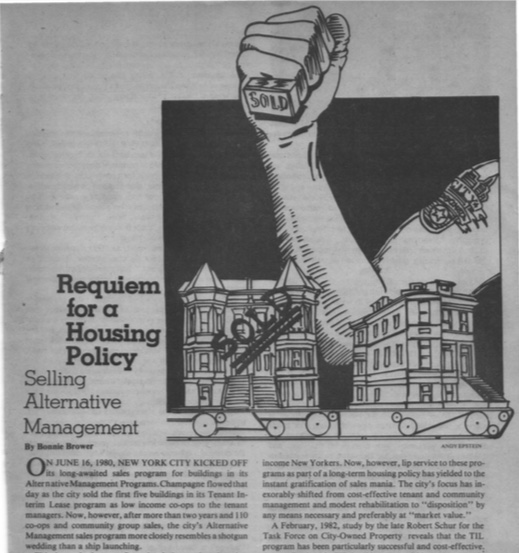Harry DeRienzo, president emeritus and special advisor at the Banana Kelly Community Improvement Association, reflects on the legacy of New York City housing organizer and advocate Bonnie Brower, who passed away on June 2.

Courtesy Eugene Patron
Bonnie Brower, right, with friend and late housing activist Frances Goldin in 1991.Harry DeRienzo, president emeritus and special advisor at the Banana Kelly Community Improvement Association, reflects on the legacy of New York City housing organizer and advocate Bonnie Brower, who passed away on June 2.
I first met Bonnie in the early ’80s when she was hired to take over the Association of Neighborhood and Housing Developers (ANHD), a membership association comprised of about 20 struggling community development and tenant advocacy groups.
The organization started as a pass-through for foundation support for community groups (apparently the foundations did not trust many of the ANHD members to responsibly manage money), while also providing technical support and assistance to members. Later, ANHD sponsored and administered a federal program known as CETA (Comprehensive Employment and Training Act).
This act was passed during the mid-’70s recession and was intended as a counter-cyclical measure to ameliorate unemployment and train workers for future private sector employment. Though successful in providing many groups with their first paid staff, offices and supplies, ANHD ran into trouble in the program’s administration. This is when Bonnie stepped in to correct course, and she worked to put the organization back on a solid financial footing.
It did not take long for Bonnie to signal the upcoming priorities the organization would embrace. While tackling those potentially devastating fiscal problems, Bonnie pushed and succeeded in changing the name of the organization to the more inclusive Association for Neighborhood and Housing Development, Inc.
This change reflected a new focus for the organization. While it continued to provide technical support for member groups, ANHD’s expanded agenda prioritized advocating for policy matters that went to the heart of the housing, burgeoning homeless and disinvestment crisis plaguing the city at that time. Bonnie became one of the most passionate and articulate voices of the housing movement, making many enemies along the way.
When Mayor Ed Koch announced that he wanted to change city policy and charge closer to market prices for low income tenants seeking to turn their landlord-abandoned buildings into limited equity cooperatives—up from $250—Bonnie led the charge to defeat that plan. A major policy thrust of ANHD under Bonnie Brower’s leadership concerned the tens of thousands of units of city-owned housing—so-called “in rem” housing, foreclosed upon by the city for failure of for-profit landlords to pay their taxes. Many do not realize this today, but in the mid-’70s the city passed legislation intended to force landlords to pay up back taxes or lose title to their buildings. This fiscal measure, intended to increase revenues, resulted in New York City creating the second largest public housing system in the country, second only to its own New York City Housing Authority (prior to this, Chicago, with 33,000 public housing units, had the second largest number of public housing units.)
The issues Bonnie took on, beyond the fight to save $250, included consolidation (the city policy of shuttering partially vacant buildings and demolishing them), tenant participation in buildings managed directly by the city, repairs and capital improvements, use of renovated vacant units to house homeless families, city budget policy, in rem sales policy, prioritization of community management, and more. These efforts never amounted to any one huge victory, but they did allow for the preservation of more truly affordable housing, more local input into city policymaking, and the creation of more low income housing—all in a period of retrenchment, near city bankruptcy and ongoing landlord abandonment.

Courtesy Eugene Patron
Brower, pictured here about two years ago during the pandemic.Challenges evolved into opportunities in the mid-1980s when the city’s economy rebounded, generating annual budget surpluses in the hundreds of millions of dollars. This improvement in the city’s fiscal situation allowed the city not only to regain control of its own operating budget (the State of New York had effectively taken over as trustee of the city’s finances to avert city bankruptcy), but also its capital budget.
Back in the bond market, the city looked to capitalize on its changed fortunes. Housing, or more specifically redevelopment of housing in areas with thousands of “in rem” units and large banks of vacant land still remaining, was one target for planned investment. From the start, Bonnie pushed for use of public money targeted to those most in need. There was hope when several ANHD leaders were invited to work with the city’s housing department to come up with a plan. After months of planning, the city informed the group that their recommendations would not be followed. Instead, the city was prepared to announce two programs—a renovation program targeted 100 percent to homeless families, and another development program that would be targeted 100 percent to middle income residents.
Bonnie pulled us in to strategize. We only had a few days before the mayor’s announcement, which we decided to upstage by having a demonstration outside City Hall, where we would preemptively announce the program and criticize it for missing the mark. Later on, in the continued struggle over the use of in rem housing, Bonnie wrote a major policy paper, “Missing the Mark: Subsidizing Housing for the Privileged, Displacing the Poor,” which outlines many of the problems advocates had with the city’s priorities.
We held the demonstration and press conference. The result was—miracle of miracles—the city saying we were mistaken in our claims and that there were, in fact, three programs. The third program, known at different times as the Construction Management Program and the Vacant Cluster Program, was a mixed income redevelopment program that targeted that “missing middle” comprised of those most in need of housing and most at risk of becoming homeless.

City Limits Archives
An article Brower penned in an early issue of City Limits magazine, in October 1982.There were so many more battles: annual budget and rezoning fights, use of urban renewal land, rent protections, for-profit inclusion and prioritization in city housing management and development, planning priorities, city housing foreclosure policy, New York City Charter Revision, and more. Throughout, even when betrayed by some of her members and allies, Bonnie never changed and was always passionate, intentional, determined, and ready to fight for the issues and people she cared about.
I am not comparing housing rights to anti-slavery, but just from the perspective of passion and personality, Bonnie was a lot like William Lloyd Garrison. Like him, she was feared by her enemies and disliked by many of her allies. This was because Bonnie was unrelenting, uncompromising, and unforgiving. History is mostly written about people who make things happen. Rarely does history reflect on those who work to prevent the worst things from happening, who make marginal differences in peoples’ lives, that for many can mean the difference between a stable family and homelessness, between a culturally and ethnically diverse neighborhood and the monotonous stranglehold of gentrified homogeneity, and for some even between life and death.
Bonnie helped make such differences in peoples’ lives. I could say we will all miss Bonnie, but we have already been missing her for quite some time. I am saddened by her passing but grateful to have had her as a friend and ally. At times, she cajoled and at other times harassed me into being more of an advocate than I thought I was prepared to be. For that, for all her unfiltered advocacy, and for her friendship, I am forever grateful.
Harry DeRienzo is the president emeritus and special advisor at the Banana Kelly Community Improvement Association.
To reach the editor, email jeanmarie@citylimits.flywheelstaging.com









One thought on “Bonnie Brower and the Art of Unfiltered Advocacy”
Who are some “unrelenting, uncompromising, and unforgiving” advocates for tenants and homeless people now?